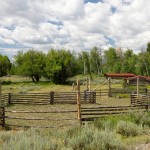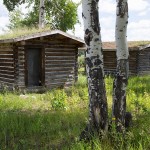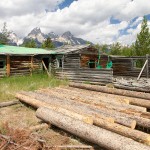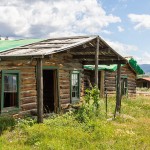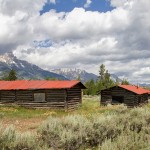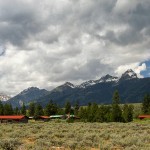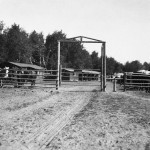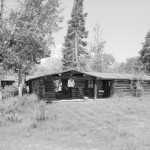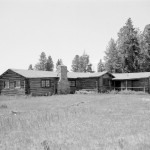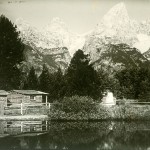Maxwell Struthers Burt, writer, novelist and poet who grew up on the East Coast journeyed to Jackson Hole in 1908 to help his colleague Louis Joy start up the JY Dude Ranch, the first dude ranch to open in Jackson Hole. Struthers Burt graduated from Princeton University in Philadelphia in 1904, and maintained his contacts with the University throughout his life. In 1911, after several years of arguing over how to best run and manage the JY, Burt split from Joy and began a survey of the valley for the perfect location to open his own dude ranch. He met Horace Carncross, the JY Ranch physician and the two started a partnership. By the end of the summer they had found the location they sought, along the Snake River bottoms south of Timbered Island. The location was ideal for the river frontage and the light breeze that kept the mosquitoes away. The two men filed for homestead patents and began the hard work of acquiring timber, supplies, and ranch hands. Their intention was to open for business the following summer. Over the winter, away from the ranch, they were able to sign on a few dudes despite the majority of the ranch being still under construction.
Both men arrived in the early spring and got to work, miraculously meeting their deadline to open for the summer of 1912. The first year was rather sparse and rough, but they managed to create an experience that would keep their guests coming back year after year. The first year, they housed 15 dudes. By 1913, the combined homestead parcels had 18 cabins, laundry, and 46 acres of cultivated land. They intended to open the ranch with dudes and transition into raising cattle. By 1917, the Bar BC controlled over 600 acres of land. They would expand to over 45 buildings including a main lodge with two dining rooms, a kitchen and two sitting rooms, 5 bunkhouses, a blacksmith shop, garage, ice house, root cellar, dining hall, ranch store, laundry and sleeping cabins. Upon the addition of the White Grass Dude Ranch to the Bar BC Ranches, Inc. there were six partners, 3 foremen and 45+ employees. The partners were Harold Hammond and Tucker Bispham of the White Grass, and Struthers Burt, Horace Carncross, Irving Corse and Joe LePage at the Bar BC.
The partnership with the White Grass Ranch would be short, lasting only four years from 1924-1928. During these years the White Grass Ranch for Boys operated in connection with the Bar BC. The idea was to allow young boys an opportunity to learn outdoor skills, and to bring their family with them to stay at the Bar BC. While the business plan had merit, it was not popular enough to sustain the partnership. In 1928, Hammond and Bispham were deeded back their ranch and the partnership dissolved. This would be a tough year for the Bar BC men as both Carncross and LePage died unexpectedly while away from the ranch. Burt and Corse were the remaining partners, and Burt was beginning to think about moving on.
A year later, Burt, growing tired of the busy dude ranching business purchased three homesteads north of Moran and built the Three Rivers Ranch. He was tiring of the increasing amount of tourists and development cropping up around the Bar BC. At the top of the bench, Burt was greeted with the Elbo Ranch’s rodeo grandstands, food concessions, a baseball diamond, and worst of all, a billboard proclaiming the commercialized ranch the “Home of the Hollywood Cowboy!” Next door were the Jenny Lake developments with a gas station and store that served as the tourist hub of the valley, seeing 30,000 visitors each summer. Burt preferred his quiet Three Rivers Ranch up north where he could work on his writing career in earnest. This ranch was solely meant for Burt and his family, as an escape from the development that he feared was rapidly spoiling the valley. In truth, the development was not as bad as it seemed, but having it on his doorstep was too much for Burt. Ironically, the immense success of his dude ranch was exactly what had caused the valley to “fill up.” No less than 12 other dude ranches opened as a direct result of guests staying at the Bar BC, and falling in love with the valley.* Countless other homesteads popped up, with many claims filed by previous guests or workers at the Bar BC.
The ranch that he had worked so hard to build was now the problem. Just six years earlier, Burt had participated in a meeting at the Maud Noble cabin in Moose to determine what to do about the growing development in the valley. A group of concerned valley residents and Horace Albright, superintendent of Yellowstone National Park, met secretly to discuss options. At that time, none of them were interested in welcoming the federal government back to reclaim the land. But now, in 1927, that was looking like the only option. Burt sat down with his neighbors from across the valley, Pierce Cunnigham and Josiah Ferrin, to write a petition urging the valley residents to understand the situation they faced. The petition called for a government agency to buy back the land, relieving the residents of their tax burdens while freeing them to create a profit on their ranches. Ninety-seven valley residents signed the petition, many of whom were previously opposed to the idea. Later that year, the Snake River Land Company was formed with the goal of quietly and inconspicuously purchasing ranches and homesteads throughout the valley. Almost immediately, many valley residents feared the Company was buying land to sell for profit, and public feeling quickly turned negative. When the valley residents learned the truth, that the newly purchased lands were to be given back to the federal government, they were incensed all the same. Had the valley residents been included in the Snake River Land Company’s plans, there might well have been more agreement. However, when residents found out that it was John D. Rockefeller, Jr. who was the financial backer, many were angered that their parcels had not been assessed at a high enough value. Others welcomed the opportunity to receive any money at all for their land, owing back taxes and having defaulted on mortgages.
In 1929, the Snake River Land Company approached Burt and Corse who sold them the Bar BC with a lease to continue dude ranching operations. Both were among the few in the valley who knew of the Company’s plans early on. Wanting to do his part to support the cause, Burt turned over the ranch to Rockefeller. In the next five years, Burt and Corse would go their separate ways and Burt ceased his management of the ranch. Two years later in 1937, he sold all of his shares to Corse and officially departed the Bar BC. In 1938 Irving Corse held the lease in full. Corse would have troubles managing the ranch, experiencing several fires over the next few years that destroyed part of the main lodge, and his main residence. He rebuilt what he could. The buildings around the ranch also deteriorated as Corse rationalized their deferred maintenance as adding to the “western rustic charm” of a dude ranch. In reality, the ranch fell into disrepair. With the shortages of supplies and labor during World War II, ranch operations came to a halt.
In 1950, Corse issued a sublease to Margaretta “Peggy” Frew Conderman, formerly from the 4 Lazy F Ranch. Peggy oversaw ranch management for the next nine years. In 1953, after several illnesses, Irving Corse died, leaving his wife Margaretta Sharpless the sole lease holder. After a fire destroys the main residence, Peggy Conderman left the valley, leaving Margaretta Sharpless to oversee the ranch. Sharpless managed the ranch for the next several decades. In 1986, too old to continue living on the ranch, she held a family auction for ranch buildings and furnishings and ceases operations. In 1988 Margaretta died and the property transferred to Grand Teton National Park. Changing attitudes on preservation over the next several decades greatly affected what remained of the Bar BC Dude Ranch. The buildings were in rough shape after already enduring years of deferred maintenance. They continued to deteriorate until the late 1990s when Grand Teton National Park initiated its first round of stabilization work. Since then, efforts to save the ranch have continued. In 2011, an official management plan was established to continue caring for the ranch in order to ensure that it would continue to stand as one of the valley’s most historically significant dude ranches.
*They were: Danny Ranch, 4 Lazy F, White Grass, Half Moon, Trail Ranch, Double Diamond, Castle Rock, Circle H, Flying V, Red Rock, STS Ranch and V Bar V. All of these ranches were created by former dudes, wranglers and others who had been on the Bar BC.
TIMELINE
1908: Maxwell Struthers Burt travels to Jackson Hole from Pennsylvania to partner with Louis Joy to start the JY Dude Ranch in 1908, the first dude ranch to open in Jackson Hole.
1911: Struthers Burt and Dr. Horace Carncross meet at the JY Dude Ranch and form a partnership, leaving the JY to start their own dude ranch. Burt had been a partner to Louis Joy on the JY, but after a falling out Burt decided to start his own ranch. Carncross had been the JY physician and was interested in owning his own land and starting a dude ranch with Burt. The men spend the summer surveying the valley to find the perfect location for a ranch. Burt knows he wants Snake River frontage with a breeze to keep the mosquitoes away. After finding their location, the two men file on adjacent homestead claims and begin to enlist the help of friends for supplies, labor and money. They intend to open the ranch the next summer.
1912: Remarkably, the Bar BC (for Burt and Carncross) opens for dudes on schedule. The first season is rough, with little food and limited accommodations for guests, but nevertheless it gains a following that will continue to grow.
1913: Burt and Carncross both file on Desert Land entries for a total of 600 acres between them.
1917-1919: Both men receive patents for their land. There are 9 dude cabins on each parcel for a total of 18, as well as a laundry, 7 smaller cabins, a well, and 46 cultivated acres for grain and oats.
1922-28: The Bar BC continues to expand, adding a dance hall, blacksmith shop, garage, store and dining hall. Burt and Carncross partner with the nearby White Grass Ranch to create Bar BC Ranches, Inc., opening a boy’s summer camp at the White Grass. Between the ranches there are 90+ buildings, six partners, 3 foremen and 45+ employees. The partners are Harold Hammond and Tucker Bispham of the White Grass, and Struthers Burt, Horace Carncross, Irving Corse, and Joe LePage at the Bar BC.
1928: Hammond and Bispham withdraw from the Bar BC partnership and the White Grass Ranch is deeded back to them. It is unclear if the boy’s camp was truly successful. The same year, Horace Carncross suddenly dies in Pennsylvania while he is home visiting family. Joe LePage then dies from pneumonia. Just Burt and Irving Corse are left as partners on the Bar BC.
1929: Burt purchases three homesteads north of Moran and builds the Three Rivers Ranch as a private retreat for himself and his family. Seeking the peace and quiet of the northern end of the valley, Burt wants to focus on his writing career rather than dude ranching. The area near the Bar BC is becoming crowded with the Elbo Ranch and concessions at Jenny Lake. These types of commercial developments are exactly what Burt fears will be the undoing of the valley, and witnessing their disturbances on a daily basis becomes too much. The same year, the first Grand Teton National Park is established and the Snake River Land Company approaches Burt about the Bar BC. Wanting to play his part in saving the valley, Burt and Corse sell the dude ranch to the Snake River Land Company with a lease to continue operations.
1935: Burt and Corse have a falling out and Burt ceased his management of the ranch.
1937: Burt sold his shares to Corse and leaves the ranch permanently.
1938: Irving Corse and his wife Margaretta Sharpless are sole leaseholders of the ranch. Their management style differs greatly from the Burts’ and the ranch suffers as a result. The buildings are no longer kept in top condition, and are allowed to deteriorate.
1939: Disaster strikes when a fire burns down a large portion of the main lodge and kitchen. The Corses rebuild a new wing.
1940s: Another fire destroys the laundry building. The Harrison family is issued a sublease and they construct a private residence on the ranch. In the latter half of the decade, ranch operations cease due to World War II and labor shortages.
1950: Margaretta Corse issues sublease to Margaretta “Peggy” Frew Conderman (of the 4 Lazy F Dude Ranch) to run and manage the ranch.
1953: Irving Corse dies.
1950-59: Peggy Conderman continues management of the ranch, divorcing her husband and marrying John Cook.
1959: Fire destroys the main residence and Margaretta Corse resumes management of the ranch.
1986: Margaretta Corse is too old and sick to continue running the ranch, so she ceases operations. A family auction is held and many small buildings, as well as furnishings are removed from the property.
1988: Margaretta Corse dies and the property is transferred to Grand Teton National Park.
1999-2015: Ongoing stabilization work is performed at the ranch to prevent further loss of the buildings. Today, many buildings still exist in a severely deteriorated state. Efforts to preserve the ranch continue.
Text by Samantha Ford, Director of Historical Research and Outreach
